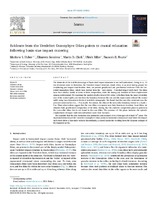Evidence from the Vredefort Granophyre Dikes points to crustal relaxation following basin-size impact cratering
Date
2021-11-24Author
Huber, Matthew D.
Kovaleva, Elizaveta
Clark, Martin D.
Riller, Ulrich
Fourie, Francois D.
Metadata
Show full item recordAbstract
The timescale of the modification stage of basin-sized impact structures is not well understood. Owing to ca. 10
km of erosion since its formation, the Vredefort impact structure, South Africa, is an ideal testing ground for
deciphering post-impact modification. Here, we present geophysical and geochemical evidence from the Vre defort Granophyre Dikes, which were derived from the - now eroded - Vredefort impact melt sheet. The dikes
have been studied mostly in terms of their composition, while the timing and duration of their emplacement
remain controversial. We examined the modern depth extent of five dikes, with three from the inner crystalline
core of the central uplift, and two from the boundary between the core and the supracrustal collar of the central
uplift, using two-dimensional electrical resistivity tomography. We found that the core dikes terminate near the
present erosion surface (i.e., <5 m depth). In contrast, the dikes at the core-collar boundary extend to a depth ≥
9 m. These observations suggest that the core dikes are exposed near their lowermost terminus. In addition, we
obtained bulk geochemical composition of the dikes, finding that the andesitic composition phase is present in
the core-collar dikes that is not found in the core dikes. The presence of this phase indicates the episodic
emplacement of impact melt into subvertical crater floor fractures.
We conclude that the dike formation was protracted and occurred over a time span of at least 104 years. The
sequential formation of the Vredefort Granophyre Dikes points to horizontal extension of crust below the impact
melt sheet above a kinematic velocity discontinuity, a crustal instability resulting from the dynamic collapse o

